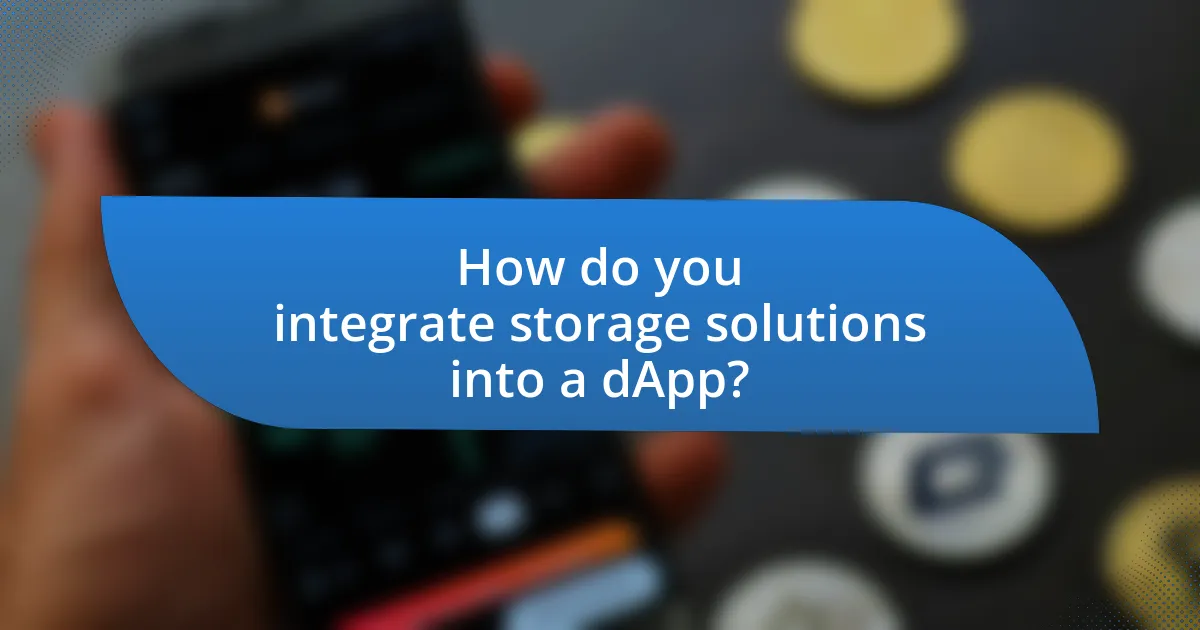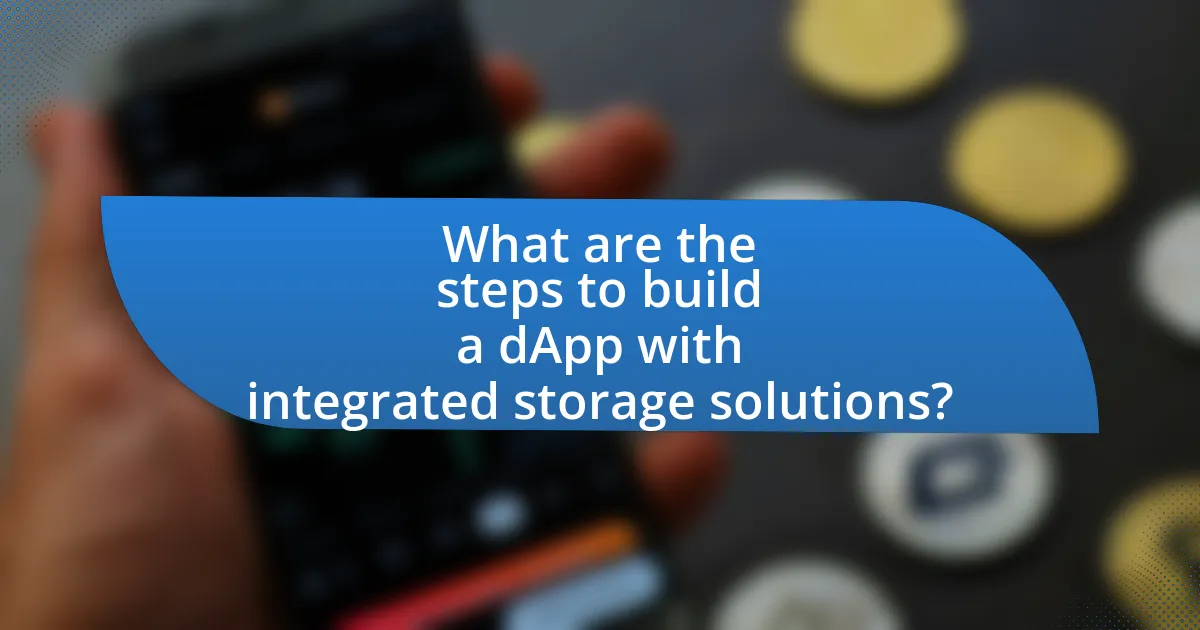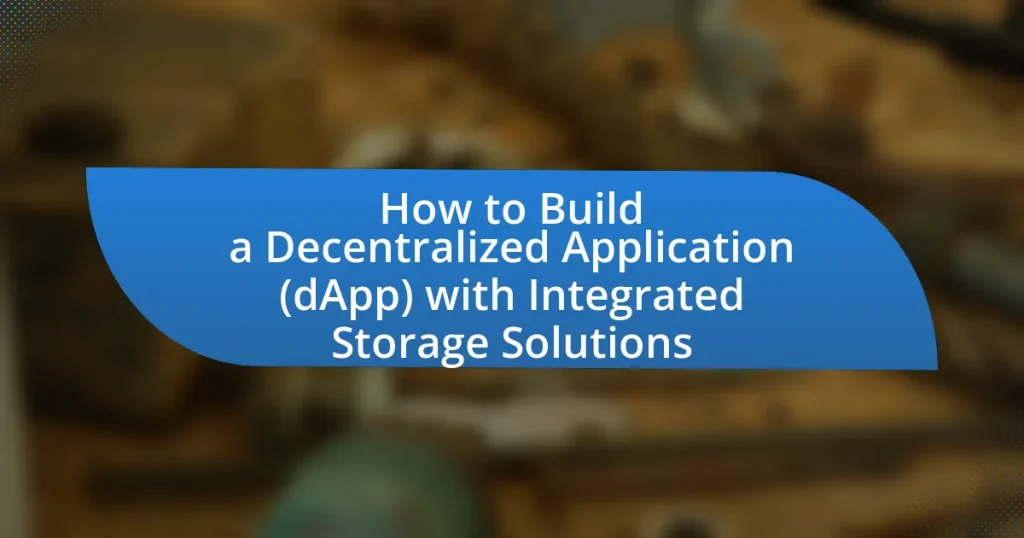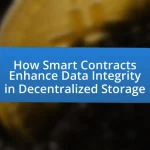A Decentralized Application (dApp) is a software application that operates on a peer-to-peer network using blockchain technology, eliminating the need for a central authority. This article provides a comprehensive guide on building a dApp with integrated storage solutions, detailing the key characteristics of dApps, their advantages over traditional applications, and the essential components involved in their development. It covers the importance of decentralization, the role of smart contracts, and various storage options, including on-chain and off-chain solutions. Additionally, the article outlines best practices for security, scalability challenges, and the steps necessary for successful dApp deployment.
-1.webp)
What is a Decentralized Application (dApp)?
A Decentralized Application (dApp) is a software application that runs on a peer-to-peer network, utilizing blockchain technology to operate without a central authority. dApps are characterized by their open-source nature, meaning their code is accessible to anyone, and they typically employ smart contracts to facilitate transactions and interactions autonomously. The decentralized structure enhances security and reduces the risk of single points of failure, as data is distributed across multiple nodes. According to the Ethereum Foundation, dApps can provide greater transparency and user control compared to traditional applications, as they eliminate intermediaries and allow users to interact directly with the application.
How do dApps differ from traditional applications?
dApps differ from traditional applications primarily in their decentralized architecture. While traditional applications rely on centralized servers for data storage and processing, dApps operate on blockchain technology, distributing data across a network of nodes. This decentralization enhances security and reduces the risk of single points of failure, as evidenced by the resilience of Ethereum-based dApps, which have maintained functionality despite server outages affecting centralized platforms. Additionally, dApps often utilize smart contracts to automate processes, ensuring transparency and trust without intermediaries, a feature not typically found in traditional applications.
What are the key characteristics of dApps?
Decentralized applications (dApps) are characterized by their reliance on blockchain technology, which ensures transparency, security, and immutability. dApps operate on a peer-to-peer network, eliminating the need for a central authority, which enhances user control and privacy. They utilize smart contracts to automate processes and enforce rules without intermediaries, thereby reducing operational costs and increasing efficiency. Additionally, dApps are open-source, allowing developers to collaborate and innovate, while users can verify the code for trustworthiness. These characteristics collectively contribute to the robustness and appeal of dApps in various sectors, including finance, gaming, and supply chain management.
Why is decentralization important for applications?
Decentralization is important for applications because it enhances security, improves user control, and increases resilience against failures. By distributing data and processing across multiple nodes, decentralized applications (dApps) reduce the risk of single points of failure, making them less vulnerable to attacks or outages. For instance, in a centralized system, a breach can compromise all user data, whereas in a decentralized system, the impact is limited to individual nodes. Furthermore, decentralization empowers users by giving them ownership of their data, fostering trust and transparency, as seen in blockchain technologies where transactions are verifiable and immutable. This structural integrity and user autonomy are critical for the long-term viability and adoption of applications in a digital landscape increasingly concerned with privacy and security.
What are the main components of a dApp?
The main components of a decentralized application (dApp) are the smart contract, the front-end user interface, and the decentralized storage system. The smart contract serves as the backend logic, executing predefined rules on the blockchain, while the front-end user interface allows users to interact with the dApp. The decentralized storage system, such as IPFS or Swarm, ensures that data is stored in a distributed manner, enhancing security and accessibility. These components work together to create a functional and user-friendly dApp that operates without a central authority.
What role do smart contracts play in dApps?
Smart contracts are essential components of decentralized applications (dApps) as they automate and enforce the execution of agreements without intermediaries. They facilitate trustless transactions by executing predefined conditions coded within the contract, ensuring that all parties adhere to the agreed terms. For example, on platforms like Ethereum, smart contracts enable functionalities such as token transfers, voting mechanisms, and decentralized finance operations, all of which are crucial for the dApp’s functionality and user interaction. This automation reduces the risk of fraud and increases efficiency, as transactions are executed automatically once conditions are met, thereby streamlining processes within the dApp ecosystem.
How does the blockchain support dApp functionality?
Blockchain supports dApp functionality by providing a decentralized and immutable ledger that enables secure and transparent transactions. This decentralized architecture allows dApps to operate without a central authority, ensuring that data is not controlled by a single entity. Furthermore, smart contracts, which are self-executing contracts with the terms directly written into code, facilitate automated processes within dApps, enhancing efficiency and reducing the need for intermediaries. The transparency of blockchain ensures that all transactions are verifiable and traceable, which builds trust among users. Additionally, the consensus mechanisms employed by blockchain networks, such as proof of work or proof of stake, ensure that all participants agree on the state of the ledger, further supporting the reliability and integrity of dApp operations.
What are the advantages of building a dApp?
Building a decentralized application (dApp) offers several advantages, including enhanced security, transparency, and user control. dApps operate on blockchain technology, which provides a secure environment resistant to hacking and fraud due to its decentralized nature. This decentralization ensures that no single entity has control over the entire network, reducing the risk of data manipulation. Furthermore, dApps promote transparency as all transactions are recorded on a public ledger, allowing users to verify actions independently. Additionally, users retain control over their data and assets, as dApps typically utilize smart contracts that automate processes without intermediaries, empowering users and fostering trust.
How do dApps enhance user privacy and security?
Decentralized applications (dApps) enhance user privacy and security by utilizing blockchain technology, which ensures data is stored in a distributed manner rather than on a central server. This decentralization minimizes the risk of data breaches, as there is no single point of failure. Additionally, dApps often employ cryptographic techniques to secure user data and transactions, making it difficult for unauthorized parties to access sensitive information. For instance, Ethereum-based dApps use smart contracts that execute transactions automatically and securely, further protecting user privacy by eliminating the need for intermediaries. This combination of decentralization and cryptography provides a robust framework for safeguarding user information against unauthorized access and manipulation.
What potential does a dApp have for scalability?
A decentralized application (dApp) has significant potential for scalability due to its ability to operate on distributed networks, which can handle increased user demand without a central point of failure. This scalability is enhanced by technologies such as sharding and layer-2 solutions, which allow for parallel processing of transactions and reduced congestion on the main blockchain. For instance, Ethereum’s transition to Ethereum 2.0 aims to improve scalability through a proof-of-stake consensus mechanism and sharding, potentially increasing transaction throughput from 30 transactions per second to thousands. This capability enables dApps to support a growing user base and complex functionalities while maintaining performance and security.

How do you integrate storage solutions into a dApp?
To integrate storage solutions into a dApp, developers typically utilize decentralized storage protocols such as IPFS (InterPlanetary File System) or Arweave. These protocols allow dApps to store data off-chain while maintaining the benefits of decentralization and security. For instance, IPFS enables users to upload files and retrieve them using unique content identifiers, ensuring data integrity and availability. Additionally, integrating smart contracts on platforms like Ethereum can facilitate interactions between the dApp and the storage solution, allowing for seamless data retrieval and updates. This approach is validated by the growing adoption of IPFS in various dApps, demonstrating its effectiveness in providing reliable and decentralized data storage.
What types of storage solutions are available for dApps?
Decentralized applications (dApps) utilize several types of storage solutions, including on-chain storage, off-chain storage, and hybrid storage. On-chain storage involves storing data directly on the blockchain, ensuring high security and immutability, but it can be costly and limited in capacity. Off-chain storage, such as IPFS (InterPlanetary File System) or centralized databases, allows for larger data storage at lower costs, but may compromise decentralization and security. Hybrid storage combines both on-chain and off-chain methods, leveraging the benefits of both approaches while mitigating their drawbacks. This multi-faceted approach to storage is essential for optimizing performance and user experience in dApps.
How does on-chain storage differ from off-chain storage?
On-chain storage refers to data that is stored directly on a blockchain, while off-chain storage involves keeping data outside the blockchain environment. On-chain storage ensures data immutability and transparency, as all transactions are recorded on the blockchain and can be verified by any participant. In contrast, off-chain storage allows for greater scalability and flexibility, as it can handle larger data volumes and faster access times without the limitations of blockchain’s block size and transaction speed. For example, Ethereum’s blockchain can store smart contracts and token data on-chain, but large files like images or videos are often stored off-chain using solutions like IPFS, which links back to the on-chain data for verification.
What are the benefits of using decentralized storage networks?
Decentralized storage networks offer enhanced security, improved data availability, and reduced costs. These networks distribute data across multiple nodes, minimizing the risk of data breaches and ensuring that no single point of failure exists. For instance, a study by the International Journal of Information Management highlights that decentralized systems can reduce storage costs by up to 90% compared to traditional centralized solutions. Additionally, decentralized storage enhances data redundancy, as files are replicated across various locations, ensuring access even if some nodes go offline. This combination of security, cost-effectiveness, and reliability makes decentralized storage networks a compelling choice for developers building decentralized applications.
How can you choose the right storage solution for your dApp?
To choose the right storage solution for your dApp, assess the specific data requirements, scalability needs, and security considerations of your application. Different storage solutions, such as decentralized storage (e.g., IPFS, Filecoin) or traditional cloud storage (e.g., AWS, Google Cloud), offer varying benefits. For instance, decentralized storage enhances data integrity and censorship resistance, while cloud storage provides ease of access and scalability. Evaluating the trade-offs between decentralization and performance, as well as understanding the costs associated with each option, will guide you in selecting the most suitable storage solution for your dApp.
What factors should you consider when selecting a storage solution?
When selecting a storage solution for a decentralized application (dApp), consider scalability, security, cost, and data retrieval speed. Scalability ensures that the storage can handle increasing amounts of data as the dApp grows; for instance, blockchain-based storage solutions like IPFS can scale effectively. Security is crucial, as decentralized applications often handle sensitive data; solutions that offer encryption and decentralized access control, such as Filecoin, enhance data protection. Cost is a significant factor, as different storage solutions have varying pricing models; for example, cloud storage may incur ongoing fees, while blockchain storage might involve transaction costs. Lastly, data retrieval speed impacts user experience; solutions that optimize access times, like Arweave, can improve performance. These factors collectively influence the effectiveness and efficiency of the chosen storage solution for a dApp.
How do user requirements influence storage decisions?
User requirements significantly influence storage decisions by determining the type, capacity, and performance needed for data management in decentralized applications (dApps). For instance, if users require high availability and low latency for real-time data access, developers may opt for faster storage solutions like SSDs or distributed databases. Additionally, user preferences for data privacy and security can lead to the selection of encrypted storage options or decentralized storage networks, such as IPFS or Filecoin. These choices are validated by the increasing demand for user-centric features in dApps, which necessitate tailored storage solutions to meet specific functional and non-functional requirements.

What are the steps to build a dApp with integrated storage solutions?
To build a decentralized application (dApp) with integrated storage solutions, follow these steps:
- Define the dApp’s purpose and requirements, ensuring clarity on the functionalities and user interactions.
- Choose a blockchain platform, such as Ethereum or Binance Smart Chain, that supports smart contracts and has a robust developer community.
- Develop smart contracts using a programming language like Solidity, ensuring they handle the core logic of the dApp.
- Select a decentralized storage solution, such as IPFS or Arweave, to store data off-chain while maintaining accessibility and security.
- Integrate the storage solution with the smart contracts, allowing the dApp to interact with the stored data seamlessly.
- Build the front-end interface using frameworks like React or Angular, ensuring it communicates effectively with the smart contracts and storage.
- Test the dApp thoroughly in a test environment to identify and fix any issues before deployment.
- Deploy the smart contracts to the chosen blockchain and the front-end to a web server or decentralized hosting service.
- Monitor the dApp post-launch for performance and user feedback, making necessary updates and improvements.
These steps provide a structured approach to developing a dApp with integrated storage solutions, ensuring functionality and user experience are prioritized.
How do you set up the development environment for a dApp?
To set up the development environment for a decentralized application (dApp), first install Node.js, which is essential for running JavaScript-based tools and frameworks. After installing Node.js, use npm (Node Package Manager) to install Truffle, a popular development framework for Ethereum dApps, by running the command “npm install -g truffle”. Next, set up Ganache, a personal Ethereum blockchain, to facilitate local testing of smart contracts. Download Ganache and create a new workspace to simulate blockchain transactions. Finally, configure a code editor like Visual Studio Code for writing smart contracts in Solidity and front-end code, ensuring you have the necessary extensions for Solidity syntax highlighting and linting. This setup allows for efficient development, testing, and deployment of dApps on the Ethereum network.
What tools and frameworks are essential for dApp development?
Essential tools and frameworks for dApp development include Ethereum, Truffle, Ganache, and Web3.js. Ethereum serves as the primary blockchain platform for deploying smart contracts, while Truffle provides a development environment and testing framework that simplifies the process of building dApps. Ganache acts as a personal blockchain for Ethereum development, allowing developers to deploy contracts, develop applications, and run tests in a controlled environment. Web3.js is a JavaScript library that enables interaction with the Ethereum blockchain, facilitating communication between the dApp and smart contracts. These tools collectively streamline the development process and enhance the functionality of decentralized applications.
How do you configure your environment for storage integration?
To configure your environment for storage integration, first, select a suitable storage solution such as IPFS, AWS S3, or Azure Blob Storage based on your application requirements. Next, install the necessary SDKs or libraries for the chosen storage solution in your development environment, ensuring compatibility with your programming language. For instance, if using IPFS, you would install the IPFS JavaScript library via npm. After installation, configure the connection settings, including API keys or access tokens, to authenticate and authorize your application to interact with the storage service. Finally, test the integration by performing basic operations like uploading and retrieving files to confirm that the environment is correctly set up.
What is the process of developing and deploying a dApp?
The process of developing and deploying a decentralized application (dApp) involves several key steps: defining the application’s purpose, selecting a blockchain platform, developing smart contracts, creating the front-end interface, integrating storage solutions, testing the application, and finally deploying it on the blockchain.
Initially, developers must clearly define the dApp’s purpose and functionality, which guides the subsequent steps. Next, choosing a suitable blockchain platform, such as Ethereum or Binance Smart Chain, is crucial as it determines the technical capabilities and limitations of the dApp. Following this, developers write smart contracts using programming languages like Solidity, which govern the dApp’s logic and interactions.
The front-end interface is then created, typically using web technologies like HTML, CSS, and JavaScript, to ensure user interaction with the dApp. Integration of storage solutions, such as IPFS or decentralized databases, is essential for managing data off-chain while maintaining decentralization.
After development, rigorous testing is conducted to identify and fix bugs, ensuring the dApp functions as intended. Finally, the dApp is deployed on the chosen blockchain, making it accessible to users. This deployment process often involves using tools like Truffle or Hardhat for seamless integration with the blockchain network.
How do you write and test smart contracts for your dApp?
To write and test smart contracts for your decentralized application (dApp), you typically use a programming language like Solidity, which is specifically designed for Ethereum smart contracts. After writing the smart contract code, you can deploy it on a local blockchain environment, such as Ganache, to simulate transactions and interactions.
Testing involves using frameworks like Truffle or Hardhat, which provide tools for writing automated tests in JavaScript or TypeScript. These tests can verify the functionality of the smart contracts by checking for expected outcomes in various scenarios, ensuring that the contracts behave as intended before deploying them to the main network.
The effectiveness of this approach is supported by the fact that automated testing can catch bugs early, reducing the risk of costly errors in production, as evidenced by numerous case studies in the blockchain development community.
What steps are involved in deploying your dApp to the blockchain?
To deploy a decentralized application (dApp) to the blockchain, follow these steps: first, develop the smart contract using a programming language like Solidity. Next, compile the smart contract to ensure it is error-free. After compilation, deploy the smart contract to the blockchain using a deployment tool such as Truffle or Hardhat. Once deployed, verify the contract on a blockchain explorer to confirm its presence and functionality. Finally, connect the front-end of the dApp to the deployed smart contract using a library like Web3.js or Ethers.js, enabling user interactions with the blockchain. These steps are essential for ensuring that the dApp operates correctly on the blockchain network.
What best practices should you follow when building a dApp?
When building a decentralized application (dApp), follow best practices such as ensuring security through smart contract audits, optimizing user experience with intuitive interfaces, and implementing efficient data storage solutions. Security is paramount; for instance, a study by ConsenSys found that 70% of smart contracts contain vulnerabilities, highlighting the need for thorough audits. User experience should prioritize seamless interactions, as research indicates that 88% of users are less likely to return to a site after a bad experience. Additionally, utilizing decentralized storage solutions like IPFS can enhance data integrity and availability, as it distributes data across a network, reducing reliance on a single point of failure.
How can you ensure security in your dApp development?
To ensure security in your dApp development, implement rigorous smart contract audits and utilize established security frameworks. Smart contract audits identify vulnerabilities before deployment, as evidenced by the fact that over 70% of hacks in the blockchain space are due to smart contract flaws. Additionally, employing security frameworks like OpenZeppelin can provide pre-audited libraries that reduce the risk of introducing vulnerabilities. By combining these practices, developers can significantly enhance the security posture of their dApps.
What common pitfalls should you avoid when integrating storage solutions?
When integrating storage solutions, common pitfalls to avoid include inadequate planning, which can lead to scalability issues, and failing to assess data security requirements, resulting in vulnerabilities. Inadequate planning often results in a mismatch between storage capacity and application needs, as evidenced by a study from the International Data Corporation, which found that 60% of organizations experience performance bottlenecks due to poor capacity planning. Additionally, neglecting data security can expose sensitive information, with the Ponemon Institute reporting that 67% of organizations have experienced a data breach due to insufficient security measures.
What are the common challenges faced when building a dApp?
Common challenges faced when building a decentralized application (dApp) include scalability, user experience, and security. Scalability issues arise because many blockchain networks struggle to handle a high volume of transactions efficiently, leading to slow processing times and increased costs. User experience can be hindered by the complexity of blockchain technology, making it difficult for non-technical users to interact with dApps. Security challenges are significant, as vulnerabilities in smart contracts can lead to exploits and loss of funds, with notable incidents like the DAO hack in 2016 highlighting these risks.
How can you troubleshoot issues related to storage integration?
To troubleshoot issues related to storage integration, first, verify the connectivity between the application and the storage solution. This involves checking network configurations, ensuring that the correct endpoints are being used, and confirming that any necessary authentication credentials are valid. Next, examine the logs generated by both the application and the storage system for error messages or warnings that can provide insights into the problem. Additionally, test the performance of the storage solution by running read and write operations to identify any latency or failure points. Finally, consult the documentation for the storage solution to ensure that all integration steps have been correctly followed, as misconfigurations can often lead to issues.
What strategies can help overcome scalability challenges in dApps?
To overcome scalability challenges in decentralized applications (dApps), implementing layer-2 solutions is essential. Layer-2 solutions, such as state channels and sidechains, enable off-chain transactions that reduce the load on the main blockchain, allowing for faster processing and lower fees. For instance, the Lightning Network for Bitcoin and Optimistic Rollups for Ethereum have demonstrated significant improvements in transaction throughput while maintaining security. Additionally, utilizing sharding can distribute the network’s workload across multiple nodes, enhancing overall performance. Research indicates that these strategies can lead to a substantial increase in transaction capacity, addressing the scalability issues faced by dApps effectively.


